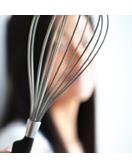Why are some chiffon cakes so nicely baked with no cracks? And mine has.
Why are some chiffon cakes so nicely baked with flavorsome dark crusts? And mine are not.
I know why! It is due to THE RECIPE and also THE OVEN!!!
Here, I will be sharing a recipe and also a baking technique that will bake an ultra soft pandan chiffon cake with the least cracks.Why the least cracks? Why not no cracks at all? Like my other ultra chiffon cakes ultra soft chiffon cakes at here, here, here, here, here, here, here and here, this pandan chiffon cake recipe has NO chemical agents like baking powder, cream of tartar or any cake stabiliser added to stabilise the cake structure. Thus, it is unavoidable to have minor cracks on these ultra soft chiffon cakes and some might shrink a little. For this cake, the least that I can do is to bake it with no major cracks. Please allow me to explain further...
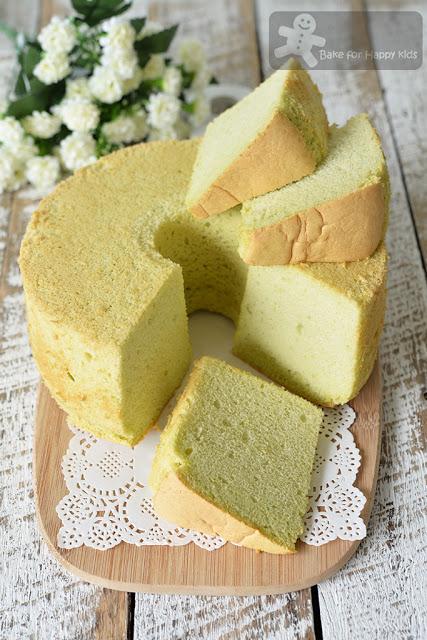
This is the ultra soft pandan chiffon cake...
that has no added chemical agents and the least cracks!
THE RECIPE
Why are some chiffon cakes so nicely baked with no cracks? And mine has.
I had a look at the recipes that bake the most beautiful flawless crack-less chiffon cakes and I'm not surprised that the recipes contains baking powder, cream of tartar and cake stabiliser that stabilise and help to rise the cakes uniformly upwards.
I have also noticed that the cake batter with 1) less liquid content 2) more flour added or 3) slightly acidic with lemon juice or orange juice or vinegar added are generally more stable than those that are not.
In order to stick on baking an ultra soft chiffon cake with no added chemical agents, my only way to bake this cake with the least crack is to incorporate slightly more flour and egg whites to stabilise the cake structure a little better.
THE OVEN
Why are some chiffon cakes so nicely baked with flavorsome dark crusts? And mine are not.
This is because you have baked your chiffon cakes with cool oven temperature that is not high enough to develop the dark crusts on your cake before the inside of your cake is thoroughly cooked. However, if your oven temperature is too high, your chiffon cakes will rise too rapidly, causing many major cracks and large bubbles to form and eventually ruin the cake's flawless look.
To me, it is almost impossible to bake a chiffon cake that is uniformly risen using a cool oven temperature and at the same time having its side and top nicely baked with flavorsome dark crusts.
Then, why am I NOT baking my chiffon cake using steam bake?
I have seen this strategy mentioned by Jeannietay's Blog at her Instagram. She has been baking her flawless chiffon cakes and many other cakes by placing a tray of boiling water in her oven. Technically, it is not totally steam bake because the chiffon cake is not placed in the tray that is filled with boiling water as the tray of boiling water is actually placed on a rack below the cake. Why did she do that? The water in the oven helps to lower the temperature of the oven and also increase the humidity in the oven, resulting the cakes not to rise too rapidly with over heating and won't dry out too with any excessive heating. Sounds like a good baking strategy? Errr... Yes and No!!!
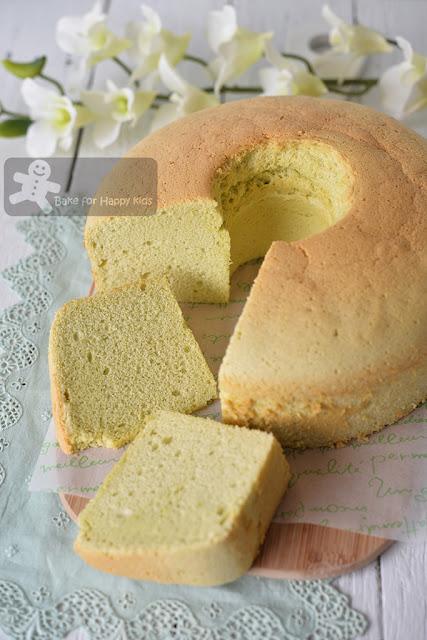
I have baked this pretty pandan chiffon cake with a tray of boiling water in my oven.
Beautiful with uniformly risen texture?
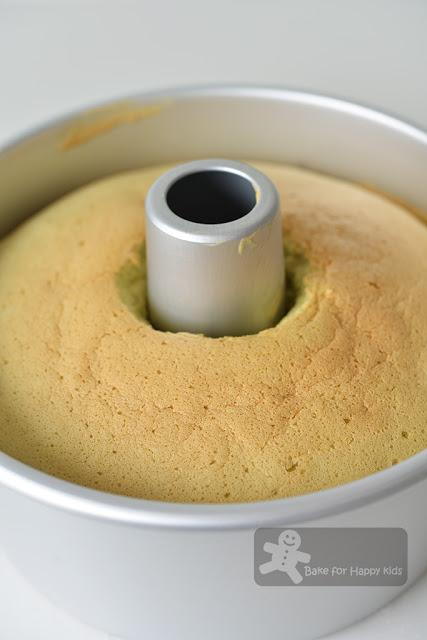
Almost flawless with no major cracks and no shrinking!

Nice texture but the cake tastes like steamed cake with eggy aftertaste!
YES. Baking your chiffon cakes with a tray of boiling water in your oven is a good baking strategy if you want your chiffon cakes to be pretty, nicely risen with no cracks, purely cottony and pale.
But what is the point if the cake looks good but didn't taste nice?This is why this baking strategy is a big NO for me because I want my chiffon cakes to taste like they have been baked, not steamed. Plus, I do prefer my chiffon cakes to have the lovely flavoursome dark crust on them.With no baking powder, cream of tartar or any cake stabiliser, I have noticed that the cake baked with a tray of boiling water won't rise very well like those that are baked with higher oven temperature and so, it is definitely NOT a good baking strategy to use if you are baking your chiffon cake with no baking powder, cream of tartar or any cake stabiliser.
What to do???
Besides steam baking, I have been exploring several ways to bake ultra soft and sensitive chiffon cakes with the least amount of cracks and these are a few strategies that I have tried:
1) Place an empty baking tray placed at the highest position in the oven as a heat shield.
2) Wrap chiffon cake pan with 2-3 layers of foil to insulate the cake from any excessive heating - can help to certain extent but not really necessary.
3) Knowing my oven and its temperature setting - MOST IMPORTANT!!!
Although different oven is different, most chiffon cakes will typically baked well in 170°C / 340ºF preheated oven but I have noticed that ultra soft chiffon cakes with the maximal of added liquid tend to rise more rapidly during baking and shrink a lot more after cooling. For this reason, I have been baking most of my ultra soft chiffon cakes in a slightly lower oven temperature at 160°C and a little longer for at least 50-55 mins.However, my Ariston oven is typically warmer than most ovens. Based on a few optimising bakes that I did before, I have learned that my chiffon cakes can be baked with the least cracks for a total of 60-70 mins, 10 mins at 160°C / 320ºF and 50-60 mins at 130°C / 265ºF.
If you think that your oven is warmer than most ovens and want to optimise your oven temperature setting just like what I did? Here's a tip for you. You can try by baking the cake in a typical 160°C / 320ºF first, then reduce the temperature to 10°C lesser until you see the first crack. Then, you can reduce the temperature to 10°C lesser or another 10°C lesser until you see that there is no more new cracks forming.
If you do this, your total baking time need to be extended from 50-55 mins plus 5 mins extra for every 10°C less that you have adjusted. For example, my total baking time is 70 mins because I have reduced my oven temperature from 160°C to 130°C and so three 10°C drop means that I will need to bake 3 x 5 mins (15 mins) extra. Resulting... my total baking time to be 55 mins + 15 mins = 70 mins!
4) If you know that your oven is not strongly heated like mine or if you want your chiffon cakes to be nicely baked with flavorsome dark crusts, please bake your chiffon cakes at 160-170°C which is has always been the standard temperature to bake all chiffon cakes.
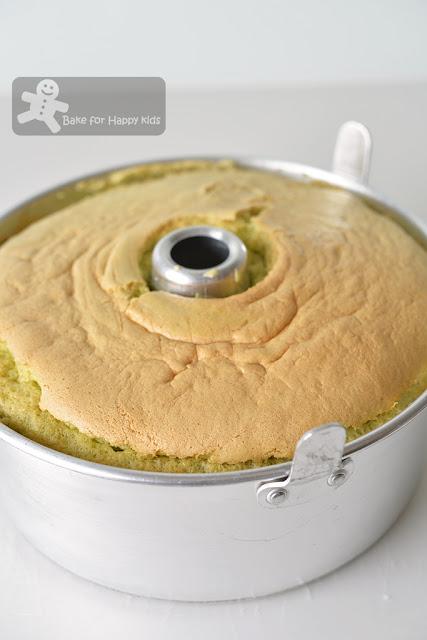
Using the optimised oven setting, this is the ultra soft pandan chiffon cake that I have baked with the least crack.
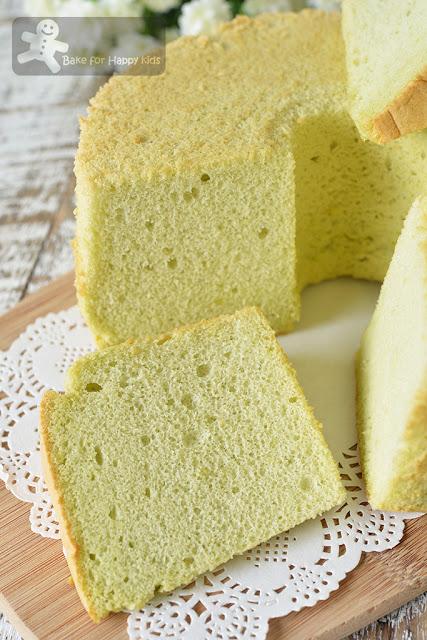
Very beautifully risen and taste cottony soft.
Despite the fact that this chiffon cake is very well risen and looks pretty with almost no cracks, it does not taste as nice as our favorite Like-Bengawan-Solo Ultimate Soft Pandan Chiffon Cake at here and Ultra Soft Pandan Chiffon Cake with milk at here simply because it doesn't have the nice golden brown crusts that we like on our chiffon cakes. Hence, I must say it is totally ok if your chiffon cakes have cracks! What really matter is the taste, not the look? What say you? No right or wrong... It is your choice!
Nevertheless, it is a good pandan chiffon cake recipe that is more than stable to bake than my other ultra soft chiffon cake recipes and here's a video showing how I baked this cake.
Want more ultra soft or interesting chiffon cakes? I will have many newly-derived chiffon cake recipes to share and so please stay tune! To get the latest updates, you can follow me at either my Facebook at here or here or my Instagram @zoebakeforhappykids
Here's the recipe.
IMPORTANT: Please use the exact weight and make sure that all ingredients are at room temperature.
Makes one tall and perfect 8-inch (20 cm) chiffon cake
For the egg yolks mixture:
6-9 fresh pandan leaves
100g coconut milk, fat reduced with 13% fat plus more if required*
90g egg yolk (about 6)
60g neutral tasting vegetable oil
a few drop pandan paste, if desired**
130g cake flour with 8% protein
20g cornflour
1/4 tsp salt
For the egg white mixture:
240g egg whites (about 7-8)
120g caster sugar
*If unavailable, use 60g regular coconut milk with 24% fat plus 60g coconut water.
Preheat oven to 160°C/320ºF or please see my above tips if you want to optimise your oven temperature setting further.
For the egg yolks mixture:
Using a kitchen scissor, snip pandan leaves into small pieces and place them into a blender or a processor container with 100g coconut milk and process. Place blitzed pandan over a muslin cloth and squeeze out the pandan-coconut-milk juice. Use only 100g of the juice. Top the mixture with extra coconut milk to 100g if the extracted juice is less than 100g.
Place the extracted juice, egg yolks, oil and pandan paste in a large mixing bowl and use a hand whisk to whisk until combined.
Sift in flour, cornflour and salt and whisk gently until the batter is smooth and combined. Set aside.
For the egg white mixture:
Using an electric mixer with a whisk attachment, beat egg whites in the lowest speed for at least 10 mins to stabilise the mixture. Increase beating speed to the next higher speed. While beating, add sugar gradually. Increase beating speed to another higher speed and continue to beat until stiff peaks form. The meringue should be very smooth with tiny bubbles. Do not over-beat the mixture.
Using a hand whisk or a spatula, gently fold in the egg whites to the egg yolks mixture in 3-4 batches. It is ok to mix the 1st batch of egg white more vigorously into the egg yolk mixture but the subsequent portions must be folded in very gently. Make sure that most of the white is not visible after folding.
Pour batter into an un-greased 20 cm chiffon tube pan. Give the pan a gentle tap. If you prefer to bake your cake with deep golden crust, bake it at 160°C for 60 mins or until it is thoroughly baked. IMPORTANT: This cake has to be baked for at least 55 mins in total. If you prefer to bake your cake with the least cracks, bake it at 160°C for 5 mins, then 130°C for 60 mins and 130°C top grill only for 5-10 mins or until the top of the cake is nicely browned - Please note that different ovens are different. Please see my above tips if you want to optimise your oven temperature setting for your chiffon cake baking.
After baking, invert the cake immediately to cool on a wire rack. Allow the cake to cool completely in the pan before removing it from the pan. Important: Do not unmould the cake by pressing it! To unmould, please use a blunt thin plastic spatula or knife to run along the cake's edges and gently push the cake out from the pan.The cake is fragile and so it is easier to slice with a serrated knife. Enjoy!
Store any uneaten in an airtight container at room temperature for up to 3 days.
Happy BakingPlease support me and like me at Facebook...
